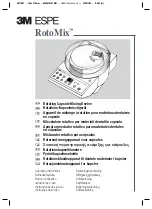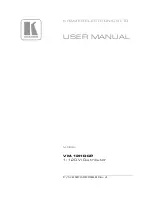
6
MAINTENANCE PROCEDURES
1. Fan Sheave
2. Belt
3. Motor Sheave
4. Deflection
5. Straight Edge
New belts have to be re-tensioned after 24 hours operation.
If Belt tensioning is required, please proceed as follows:
1. Loosen the lock nuts on the Motor Base Adjusting Screws.
2. Turn the Motor Base Adjusting Screws clockwise to tension the
belt, or counter-clockwise to relieve belt tension. During
adjustment of belt tension the drives should be rotated several
times by hand to evenly distribute the tension throughout the
belt.
3. When the belt is properly tensioned, retighten the locking nuts
on the Motor Base Adjusting Screws.
Note: There should be no “chirp” or “squeal” when the fan motor is started.
DRIVE ALIGNMENT
Proper drive alignment ensures maximum belt life. Alignment is
checked for standard drives after correct belt tensioning by placing
a straightedge across both sheaves as shown in the Figure below.
When the drives are properly aligned the gap measured between
straightedge and sheave does not exceed 0,5 mm per 100 mm of
fan sheave diameter.
1. Motor Sheave
2. Fan Sheave
3. Points of Contact
LOCKING COLLAR
The excentric locking collar of the bearing at the drive end ensures
that the inner bearing race is secured to the fan shaft. Locking
collars can be set using the following procedure. (See Figure below)
1. Stop fan(s) and remove side access panel(s).
2. Loosen the set screw.
3. Using a drift pin centerpunch, tap the collar (in the hole provided)
tangentially in the direction of rotation while holding the shaft.
4. Retighten the screw.
5. Install access panel(s) and start fan(s).
1. Direction of Rotation
2. Drift Pin: Tap the locking collar in direction of fan rotation until cam is
locked.
3. Tighten set screw.
ROTATION OF FAN(S) AND PUMP(S)
Fans must rotate without obstruction and both fans and pumps
must rotate in the correct direction, which is indicated by arrows on
the equipment. Check proper functioning as follows:
1. Stop fan(s) and pump(s).
2. Turn the fan by hand to ensure rotation without obstruction.
Remove obstruction, if present.
3. Start the pump(s) and check for the proper rotation as indicated
by the arrow on the pump cover. If rotation is wrong, stop pump
and correct electrical wiring.
4. Start the fan(s) and check for proper rotation as indicated by the
arrow on the fan housing. If rotation is wrong stop fan(s) and
correct fan motor wiring.
MOTOR VOLTAGE AND CURRENT
Check the voltage and the current of all three legs of the fan and
pump motors. The current should not exceed the nameplate rating.
After prolonged shutdown the motor insulation should be checked
with a megger insulation tester prior to restarting.
UNUSUAL NOISE AND VIBRATIONS
Unusual noise and/or vibration are the result of malfunctioning of
mechanical components or operational problems. If this occurs, a
thoroughful inspection of the entire unit followed by immediate
corrective action is needed. If required, consult your local BAC
Balticare representative for assistance.
GENERAL CONDITION OF THE EQUIPMENT
The inspection should focus on following areas:
- damage of corrosion protection
- signs of scale formation or corrosion
- accumulation of dirt and debris
- presence of biofilms
Smaller damages of the corrosion protection can be repaired.
Gavanised steel components should be inspected for blemishes and
corrosion. Affected areas can be wire brushed and recoated with a
cold galvanising compound such as zinc rich compound.
If there is evidence of scale formation (more than 0,1 mm) or
corrosion, water treatment regime must be checked and adjusted
by the supplier.
Any dirt and debris need be removed following the CLEANING
PROCEDURES described in this manual (See page 9<).
Figure 3: Fan Belt Check and Adjustment
Figure 4: Checking sheave alignment
Inspections and Corrective Actions
Figure 5: Locking Collar Assembly


































